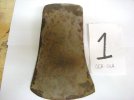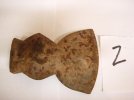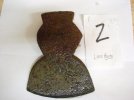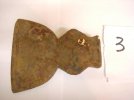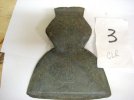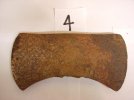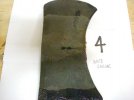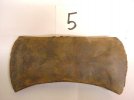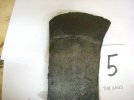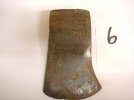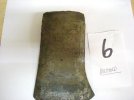I'm soaking a head now in vinegar. I started with white distilled and then add apple cider for more volume as the regular ran out. I noticed that toward the bit, the steel turned solid black. Is the bit treated different or something? It rubs off easily onto your fingers turning them black, but doesn't completely wash of when rinsed. I'll let it sit a few more days and hit it with some 1200 wet/dry and see what it looks like. Lots of crap coming off from the vinegar. Can't wait to see the end results.
-
The BladeForums.com 2024 Traditional Knife is available! Price is $250 ea (shipped within CONUS).
Order here: https://www.bladeforums.com/help/2024-traditional/
You are using an out of date browser. It may not display this or other websites correctly.
You should upgrade or use an alternative browser.
You should upgrade or use an alternative browser.
Removing Rust From Axes - Experiment+RESULTS
- Thread starter Operator1975
- Start date
I'm soaking a head now in vinegar. I started with white distilled and then add apple cider for more volume as the regular ran out. I noticed that toward the bit, the steel turned solid black. Is the bit treated different or something? It rubs off easily onto your fingers turning them black, but doesn't completely wash of when rinsed. I'll let it sit a few more days and hit it with some 1200 wet/dry and see what it looks like. Lots of crap coming off from the vinegar. Can't wait to see the end results.
that is the heat treated area you are seeing turn so dark
- Joined
- Sep 24, 2010
- Messages
- 2,395
Here are the results after 7 days of soaking.
Disclaimer - I am no expert here - just tinkering and see what is better, worse, etc. Any feedback is much appreciated.
The before and after pics will be loaded, one of each. I will have to make multiple replies to get them all to show, then a comment reply as well.
For the pics -
1. Coca Cola
2. Lime Away
3. CLR
4. White Vinegar
5. The Works Toilet Bowl Cleaner
6. Mustard
Disclaimer - I am no expert here - just tinkering and see what is better, worse, etc. Any feedback is much appreciated.
The before and after pics will be loaded, one of each. I will have to make multiple replies to get them all to show, then a comment reply as well.
For the pics -
1. Coca Cola
2. Lime Away
3. CLR
4. White Vinegar
5. The Works Toilet Bowl Cleaner
6. Mustard
Attachments
Last edited:
- Joined
- Sep 24, 2010
- Messages
- 2,395
- Joined
- Sep 24, 2010
- Messages
- 2,395
- Joined
- Sep 24, 2010
- Messages
- 2,395
Looking at the overall results - this is what I would say :
When I removed the head I cleaned it with the garden hose and a plastic brush.
Overall, hard to beat the vinegar. If you had to look at cost, ease of use, smell, etc, it would win in this particular go around. The Works (toilet bowl cleaner, not the other one) did really well, as did CLR, but both stink, need gloves, and cost more.
Mustard - jury is still out. It did ok. I think I needed to make sure you move it around, keep it moist(someone else pointed this out earlier or in another thread). I didnt keep it in a bag, so i made a cake like substance on the head, which i actually had to pry off. So I will say at this time, it needs another experiment.
Coca - Cola - ok at best. Not alot of action here. Pretty average to below average results. Not a lot of stuff in the bucket like the others.
Vinegar - This stuff did the job. All kinds of debris in the bucket when done. As you can see from the picks, just needs a good once over, and you would be good to go. I was pretty impressed by it.
The Works - serious stuff. But too stinky and too many things to prep and worry about for me. Same with CLR and Lime Away. Though I will say they did their jobs overall.
So that is the first experiment. I didnt cure a disease or invent a new kind of energy, but hopefully this can help, or we can continue to build on it.
When I removed the head I cleaned it with the garden hose and a plastic brush.
Overall, hard to beat the vinegar. If you had to look at cost, ease of use, smell, etc, it would win in this particular go around. The Works (toilet bowl cleaner, not the other one) did really well, as did CLR, but both stink, need gloves, and cost more.
Mustard - jury is still out. It did ok. I think I needed to make sure you move it around, keep it moist(someone else pointed this out earlier or in another thread). I didnt keep it in a bag, so i made a cake like substance on the head, which i actually had to pry off. So I will say at this time, it needs another experiment.
Coca - Cola - ok at best. Not alot of action here. Pretty average to below average results. Not a lot of stuff in the bucket like the others.
Vinegar - This stuff did the job. All kinds of debris in the bucket when done. As you can see from the picks, just needs a good once over, and you would be good to go. I was pretty impressed by it.
The Works - serious stuff. But too stinky and too many things to prep and worry about for me. Same with CLR and Lime Away. Though I will say they did their jobs overall.
So that is the first experiment. I didnt cure a disease or invent a new kind of energy, but hopefully this can help, or we can continue to build on it.
Awesome test! Thanks. I am using vinegar now. I am soaking a head that was partially painted and the apple cider vinegar actually lifted the paint off after just one day. One comment on the mustard is that it might actually be the vinegar in teh mustard that is doing the work. Might as well just hit it with the straight stuff and be done with it. Just my take on it. Thanks for all the work you did.
- Joined
- Jan 1, 2010
- Messages
- 608
Thanks for the great thread. I have a double bit Chemical Axe that I want to refinish and was waiting for your results. Vinegar it is than! Thanks again, Operator1975, I appreciate you doing this.
Dan
Dan
- Joined
- Jul 17, 2009
- Messages
- 414
Thanks for the test and sharing results. Practical, helpful information has been delivered. Thanks.
- Joined
- Aug 28, 2010
- Messages
- 5,431
Thanks for doing this. Great info.
- Joined
- Nov 6, 2008
- Messages
- 712
Vinegar is acidic - white vinegar is strongest, then apple cider, then wine, then rice.
Coke has phosphoric acid in it - but not enough to eat metal.
Muratic acid is very strong and will burn / etch metal easily.
Mustard is a combination of vinegar and mustard seeds. The vinegar does the work.
Coke has phosphoric acid in it - but not enough to eat metal.
Muratic acid is very strong and will burn / etch metal easily.
Mustard is a combination of vinegar and mustard seeds. The vinegar does the work.
- Joined
- Apr 14, 2008
- Messages
- 1,810
I have used red devil lye in a plastic bucket to clean up baked on grease on cast iron. Wear rubber gloves and eye protection. An old lady taught me that trick. Wash it good when done. I never thought to try it on rusted tools. It may work. Thanks for the results. If it doesn't work, at least you will know how to clean cast iron.
- Joined
- Jun 16, 2003
- Messages
- 20,207
Why think they will dissolve iron oxide instead of steel?
- Joined
- Feb 9, 2008
- Messages
- 1,397
This past fall I went here..http://http://www.facebook.com/pages/Institute-For-Traditional-Ozark-Crafts/307595563437 qnd at work shop on wood working planes the showed how to remove rust with electrolisis(sp) using a 5 gallon bucket with a couple of bars of steel bolted in it at the top and connected by wire then fill the bucket with water and add a tablespoon of arm and hammer laundry soap for each gallon of water in the bucket and stir. Now take a battery charger and set it at 2amps only 2 amps. put one clamp on your rusty metal and the other clamp on the metal in the bucket, and it matters which is which but I forgot I think postive on the rusty stuff and the negative on the sacrificial bars in the bucket, plug it in and leave it over night the rust will flow from the tool to the baras as long as nothing gets in the way of directly from tool to bars. the bucket they had used 4 pieces of bar stock about 1/4" by 1" the height of the bucket spaced at 90 degrees, fastened at the top of the bucket by a 1/4 " bolt so the could hang down in the bucketand from bolt to bolt to bolt to bolt the connected them with an scrap of copper wire so them would all hook up to battery charger. this worked good and didn't damage metal they had an axe head in this machine for about 2 or 3 hours and that wasn't long enough, but it loosened so scotch brite wiped it off easily. It left the patina on the metal if you didn't shine it up too much. Once all the rust is gone it won't hurt anything if it sit some extra time if positive and negative are in the right place
WARNING I may have which way to hook up the wires on the battery charger so if you have it going for a few hours and nothing is happening you may want to switch becaause you will pull the metal out of your rusty tool instea and eat it up. The electric charge is important on which way the current goes.
They were using this to clean up old Jack planes and after a couple of days of cooking about all they need is a good cleaning. Maybe if Santa brings me a camera I can post a "How To" and show how to build one.
Pat
WARNING I may have which way to hook up the wires on the battery charger so if you have it going for a few hours and nothing is happening you may want to switch becaause you will pull the metal out of your rusty tool instea and eat it up. The electric charge is important on which way the current goes.
They were using this to clean up old Jack planes and after a couple of days of cooking about all they need is a good cleaning. Maybe if Santa brings me a camera I can post a "How To" and show how to build one.
Pat
- Joined
- Feb 3, 2007
- Messages
- 85
Naval Jelly is purpose built designed to do this. Dilute Ferric Chloride works extremely well also to gently remove rust and leave a very durable etch.
The food items are all mediocre by comparison for rust removal and quality of the finish they leave behind
The food items are all mediocre by comparison for rust removal and quality of the finish they leave behind


